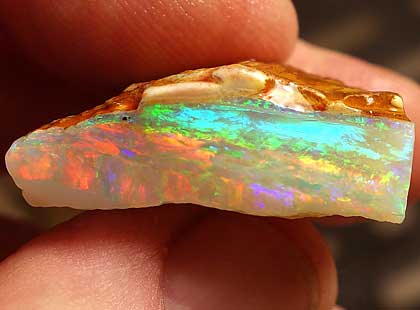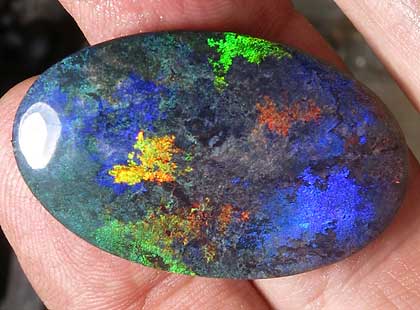Birthstones by the Month
One of the October Birthstones is Opal

Bolder Opal
Australian Boulder opals are some of the most valuable type of opals. Boulder opals are distinguishable by the layers of opal fissures inside the cracks of the ironstone. [2]
Opal Mineral Form
Not technically a mineral because of a lack of crystal structure, Opals are amorphous, meaning they do not have a clearly defined shape. Made from hardened silica gel (hydrous silicon dioxide), there are two distinct families of opals. Opals displaying iridescence are labeled as Precious while those without this effect are Common. Large flashes of a distinct color are referred to as schiller.

Opal October Birthstone
Opal is the national gemstone of Australia. Australian opal has often been cited as accounting for up top 97% of the world's supply of precious opal. [1]
Opal Facts
Originally named from the Sanskrit word “upala” meaning “precious stone,” the Greeks later coined the term “opallos” which roughly translates to seeing a color change. This gemstone is found in a wide array of deposits such as nodular, veins, crusts, stalactite and more, especially in igneous environments. While Australia continues to be the largest supplier of Opals, other major deposits are found in Hungary, Brazil, Mexico, Sudan and multiple states in the USA including Idaho, Nevada, California and Oregon. Especially black opals are popular for men’s jewelry, though they are best suited as pendants, earrings, brooches and tie tacks so the stone avoids potentially damaging blows that could result in bracelet settings.
The characteristics of Opal
Opal is most memorable for its unique iridescent color play called opalescence, sometimes referred to as “fire” or “flash.” The play of light is most intense when Opal is wet and has been displayed and sold directly from buckets of water to showcase this.
It is believed the silica forms in spheres within Opal, and is arranged in a particular pattern that results in diffracting light, causing the unusually wide spectrum of colors. Opals are most typically vitreous in luster.
Cut and Clarity for the October birthstone
Opal provides unique difficulties for gem-cutters during the cutting process. Internal cracks, called crazing, have been known to form in some Opals. This cracking is usually unpredictable and can occur while the gemstone is being mined or during the shaping process. Crazing is a direct result of the Opal losing too much moisture all at once. Crazing can occur from light as well, and Opals should therefore never be stored or displayed in intense direct sunlight such as window displays. Most commonly, due to the cloudy nature of Opals, this gemstone is best-suited for cabochons though it is also cut into various bead shapes. Irregular cut shapes are commonly found for Opal, as gem-cutters attempt to best capitalize on the play of light.
The value of Opal
Precious Opals far surpass Common Opals in cost. There have been Opals with high enough quality and intense iridescence to fetch prices higher than diamonds. It may be surprising to note, the black variety of Opal is actually the most valuable as the colorless background provides an ideal base for intense opalescence. Other highly sought after varieties include white Opal and Fire Opal (also referred to as Mexican Fire Opal). Large schiller fetches a higher price than small or scattered flashes.

Gem Grade Precious Opal
Rough opal from Coober Pedy, South Australia, Dead Horse Gully area. This is high grade precious opal showing full thickness play of color. It qualifies as crystal opal based on the near transparency of the background. [5]
Is Opal ever treated?
To improve Opal’s luster waxing is not uncommon. Waxing has also been used to improve stability of the rough Opal material since the gemstone is considered brittle.
More about Opal the October birthstone
Especially because of the possibility for crazing, proper storage and cleaning is necessary so as not to cause dehydration of Opals. It’s best to wipe clean with a moist cotton cloth and store inside a sealed plastic bag with the cloth so there is constant hydration. It is unwise to attempt cleaning with bleach or other chemical cleaners. Ultrasonic cleaners clean by vibration and are likely to crack Opal due to its medium Moh’s hardness in the 5-1/2 to 6-1/2 range.
The American Gem Society's October Birthstone page has more information to help you buy from knowledgeable and skilled jewelers and to help you make the most informed buying decision.
Image Attribution
- By Reno Chris at en.wikipedia [Public domain] from Wikimedia Commons
- By Hannes Grobe (Own work) [CC BY-SA 2.5], via Wikimedia Commons
- By Dpulitzer (Own work) [CC BY-SA 3.0], via Wikimedia Commons
- By Dpulitzer (Own work) [CC BY-SA 3.0], via Wikimedia Commons
- By Dpulitzer (Own work) [CC BY-SA 3.0], via Wikimedia Commons

